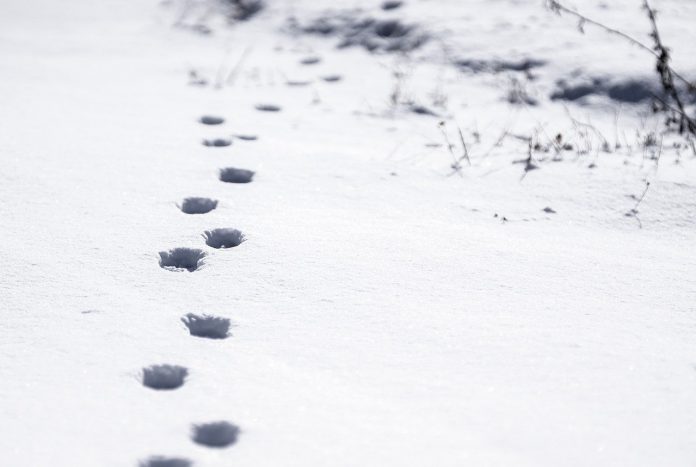It’s hard to remain hidden in the winter. Barren trees stretch across the horizon and frosty white snow covers the ground. Every step I take leaves a trail behind me.
Walking with my daughters, we can clearly see elevation changes in the landscape without the camouflage of thousands of green leaves and shrubs. Fallen trees are scattered down the ravine toward a small stream that trickles under the ice in the valley.
At one point, an old deer trail cuts in front of us perpendicular to our path. Two-toed hoof prints are evidence that a large deer crossed recently in the fresh snow. I can even see the imprints of dewclaws pressed into the snow. This is their heavily trafficked “high” way. Deer usually choose this route that follows the ridgeline.
Tracking tells me about the journeys of woodland creatures that make their home in the woods behind my house. They tell a story to my children who watch for clues along the trail.
Deer crossing
As for the deer tracks, we can tell by the most recent tracks that the deer was walking. The tracks are in sets of two, the front leg and hind leg on one side alternate with both legs on the other side. Unless under emotional stress or in pursuit, most deer travel by walking.
There are two other gaits to watch for in deer tracks, trotting and galloping. If a deer were to increase its speed to a trot, the tracks would be farther apart vertically in sets but closer together horizontally as if being pulled towards a centerline.
A longer space in between sets of four prints would indicate the deer was galloping. If a deer is galloping, it is stressed for some reason.
Muskrats
Farther down the path, closer to the creek, we found another trail drastically different from the deer tracks. This trail was like a line drawn through the snow continuing into the marshy vegetation before disappearing near the edge of the creek. The line was a sure sign of a muskrat.
Muskrats are native to North America and closely related to other rodents like mice, rats and gerbils. They are similar in size to large rats weighing up to 4 pounds and are about 24 inches in length with a long, scaly tail that is typically 7-11 inches. The tail is used as a rudder, and it’s no surprise these small critters are excellent swimmers.
Muskrats have a voracious appetite; they eat a third of their body weight a day in plants and small animals like snails, salamanders and small birds. Many people consider muskrats to be pests. This could be in part due to their reproduction rate. A female muskrat can produce 35 offspring, called kits, a year.
Muskrats have thick, waterproof fur that for decades was sought after by trappers. In a great marketing scheme during the 20th century, muskrat fur was sold as Hudson seal fur. These coats can still be found on sites like eBay and Etsy.
I asked my daughters if they would wear one of the coats. After they distorted their faces into a scowl they emphatically told me no. In their mind, a Hudson seal fur coat is equivalent to skinning rats and calling it a jacket.
Mice
The last tracks I came upon were tiny with something lightly dragging between each set. They had to be left there by mice. I could see two small indents side by side and a line connecting each set from their tail dragging in the snow.
Mice can travel under deep snow as well in burrows and tunnels. They sometimes eat the bark off of young sapling trees. Due to their nocturnal nature, it is unusual to see them out and about during the day.
Finally, the only tracks left in the snow were my own and my daughters’ leading us back to our warm, cozy home.
I am the opposite of the trees shedding their leaves; I pile on sweatshirts, sweaters and blankets in the cold winter months. Against my natural desire, I will continue to venture out in the snow this winter.
Writer Roald Dahl once said, “And above all, watch with glittering eyes the whole world around you because the greatest secrets are always hidden in the most unlikely places. Those who don’t believe in magic will never find it.”













